What about Pisa?
Although Pisa is known worldwide for its Leaning Tower, the bell tower of the cathedral, the city of over 90,000 residents contains more than 20 other historic churches and various bridges across the Arno River. Pisa can be easily reached by plane, train or car. The Galileo Galilei airport is an International airport 10-15 minutes far from the center by taxi.
The main train station, located in the centre of the city, is well connected with major Italian cities such as Florence, Rome, Naples and Milan. Travelling by car is also very easy since Pisa is connected with many other Italian cities with excellent toll and toll free highways.
A bit of history
There is no way to understand what Pisa is today without having an idea of what it has been through the centuries. Etruscan settlement, Roman city, medieval commercial harbour, powerful Maritime Republic, bitter enemy of Florence, Lucca and Genoa, magnificent noble city in the 17th century, host town for many artists in the 19th century, excellent University town in the last few centuries, and home to some of the most prestigious Academies in the world such as Galileo Galilei. Pisa is definitely more than a bell tower, albeit a very beautiful one.
The city is divided in two halves by the River Arno, the same which passes through Florence, and which flows into the Tyrrenian Sea at Marina di Pisa. The coast is now 12km away, since over the centuries debris from the river has sanded up its watercourse downstream moving the coast further away. In the Early Middle Ages, Pisa was a very lively port and a rich commercial centre. Moreover, it was one of the four Maritime Republics (the other three being Genoa, Venice and Amalfi), which fought each other for control of the Mediterranean Sea. This was a period of victories and wealth for the city, which had colonies and commercial bases all over the Mediterranean coasts and was feared and respected. After several glorious centuries, Pisa started to decline in power and wealth in the 13th century. The conflicts with another Maritime Republic, Genoa, resulted in a very bad defeat in the battle of the Meloria (1268), which signalled the beginning of the loss of influence as a maritime power. In the same period, the conflicts with the Guelph cities in Tuscany began, along with serious internal struggles for the control of the city.
One of the most famous and hated characters in the history of Pisa is Count Ugolino della Gherardesca, whose story is told in Dante’s Divina Commedia (Devine Comedy). He was accused of treachery at the Meloria battle, but a few years later he became Lord of Pisa. In 1289, the Archbishop ordered his imprisonment. He was locked up in the Gualandi Tower with his children and grandchildren and left there to starve. The legend says that he ate his children and grandchildren. Actually, this is an allegory – or so we hope! Today, where the old Gualaldi tower used to stand, there is the beautiful library of the Scuola Normale Superiore and a plaque commemorates this sad story.
During the 14th century, Pisa continued to suffer battles and revolts. The date that all Pisans remember is October 9th 1406, when the hated Florentine army entered the city and Pisa was placed under the rule of Florence where it remained until the creation of the Italian state in 1861.
In the 18th, 19th and 20th centuries Pisa continued to grow with its University, which is one of the most prestigious in Italy and in Europe. The city was badly damaged by bombing during World War II, but it is now being totally restored and brought back to its ancient splendor.
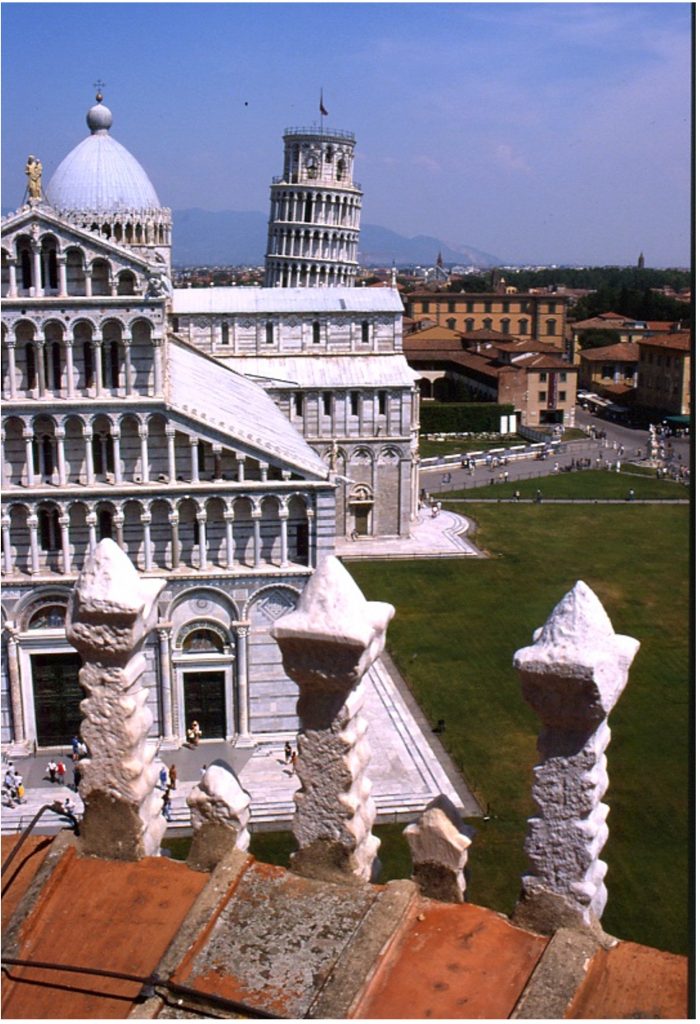
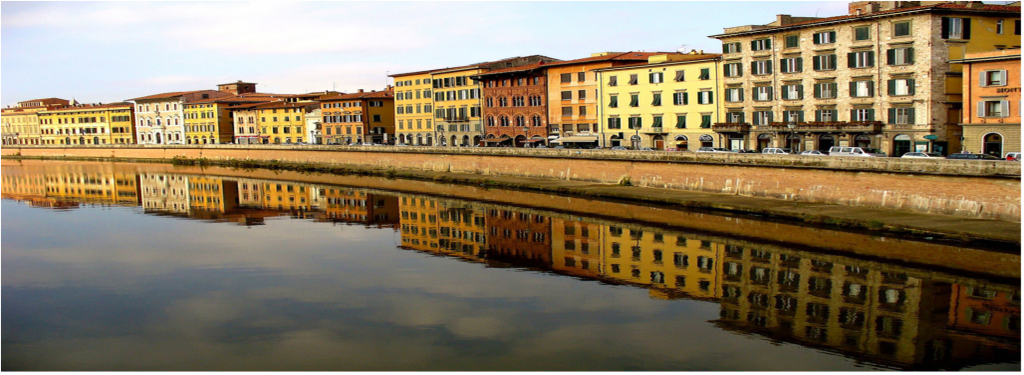
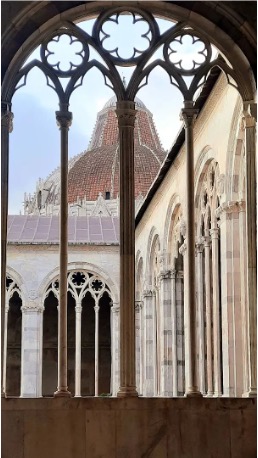
Monuments
Today, the city, severely damaged by the violent bombing and artillery in 1943 and 1944, retains splendid monuments.
In the north-west of Pisa there is an immense green lawn, known as the “Campo dei Miracoli” or the “Piazza dei Miracoli” (Field of Miracles or Square of Miracles), on which four impressive buildings stand in gleaming white marble. These imposing structures are the enormous, breathtaking Duomo (cathedral) – built almost 1,000 years ago, the cathedral’s bell tower – better known as the Leaning Tower of Pisa, the circular Battistero (Baptistery) – the largest of its kind in the whole of Italy, and the Camposanto – also known as the Holy Field, without doubt one of the most beautiful cemeteries in the world. This area of Pisa and these remarkable Pisan buildings combine Moorish, Gothic and Romanesque architectural features.
The Leaning Tower of Pisa isn’t the only edifice no longer standing upright in the city. Pisa’s unsteady, sandy soil under the Field of Miracles has resulted in other problems that initially are not quite so obvious. The baptistery leans noticeably towards the north and also, when viewed at certain angles, Pisa’s Duomo cathedral is far from straight. There are also a couple of small bell towers (campaniles) in Pisa which have also shifted and these have been nicknamed ‘The Other Leaning Towers of Pisa!’
The historic city centre of Pisa is concentrated on the north bank of the River Arno and is still surrounded by 12th-century walls. The ‘high street’ is the long and curving Via Santa Maria which connects the Campo dei Miracoli with the Lungarno (Embankment). The social centre of Pisa is the Piazza Garibaldi, located on the north side of the Ponte di Mezzo (Middle Bridge) and also the elegant Borgo Stretto, full of interesting shops and cafés. There are also many tourist attractions nearby in the neighbouring cities of Florence and Lucca.
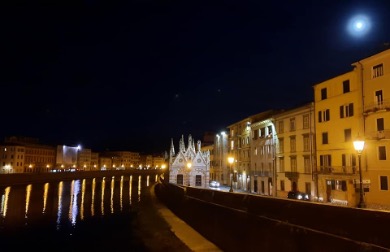
The University of Pisa
Pisa is also known for its excellent University, which was established in 1343 and has become one of Italy’s top schools. The University of Pisa is one of the most renowned Italian universities. It was formally founded on 3rd September 1343 by an edict of Pope Clement VI, although there had been lectures on law in Pisa since the 11th century.
The University has the oldest Botanical garden founded in 1543 by naturalist, doctor and botanist Luca Ghini (1490-1556), the Botanic Garden is the first university botanic garden in the world.
Originally built on the banks of the river Arno, it was moved to the current site in 1591 and then gradually expanded up to about two hectares. It houses plants from several continents: the succulents of the African and American deserts, the aromatic plants of the Mediterranean maquis, the species of the Tuscan wetlands, and numerous centuries-old trees. In the Botanic Garden are also cultivated several endangered plants of conservation interests.
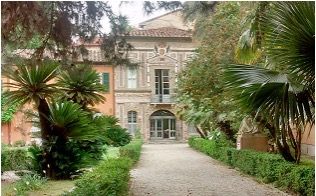
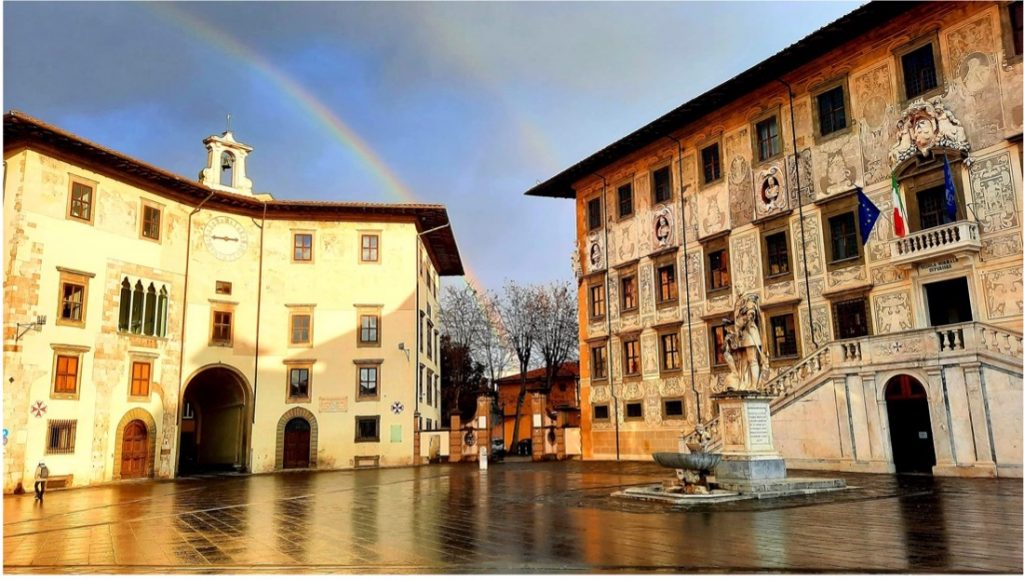
Tuttomondo
Pisa houses the last mural made by US street artist Keith Haring before his death in 1990: ‘Tuttomondo’. The work, a tribute to life and peace in the world, originated from the encounter between the artist and an Italian student in New York who invited him to visit his hometown, Pisa. Keith was deeply touched by the zest of the city, but above all by the pastel colors of the Sant’Antonio District, to the point that he made an incredible mural that became the symbol of Pisa’s regeneration in the 90s.
‘Tuttomondo’, painted on the exterior wall of the Convent of St. Anthony Abbot, covers an area of 180 square meters and consists of 30 colorful figures joined together: every character, in a special symbolic pose, dances to the rhythm of an African dance and represents a message of peace:
The anthropomorphic animals symbolize man’s love for nature.
The three world’s concentric ethnic figures, holding a heart in their hands, represent the fight against racism.
The man forming the symbol of infinity with his body is the metaphor of the endless cycle of life.
The Pisan cross, the symbol of the city, is represented by the four figures joined at the center of the mural the woman with the baby in her arms is a symbol of maternity the television represents openness to the world the man-scale is a symbol of ambition.
The hand with five men symbolizes human labor.
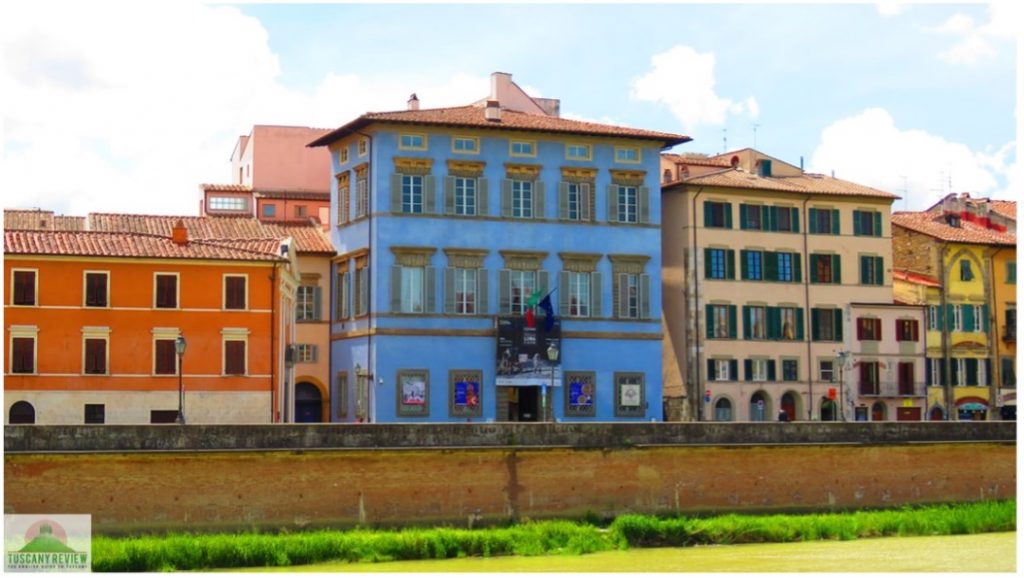
Santa Maria della Spina is a small church erected around 1230 located on Arno riverbank like a little gem and is an extraordinary example of Pisan Gothic. It was originally an oratory: its name comes from the reliquary containing a thorn from Christ’s crown, which the small church acquired in 1333, though it is today found in the Church of Santa Chiara.
The church has undergone numerous changes, especially given its proximity to the Arno, which is a threat to its stability: the most radical renovation was in 1871, when it was dismantled and rebuilt higher up the river. The church was raised about a metre, many sculptures were replaced with copies and the sacristy was knocked down.
The church was recently restored and is open to the public a few days per week. Inside visitors can admire the impressive Madonna of the Rose by Andrea and Nino Pisano, other furnishings not removed from the church and temporary exhibitions that are occasionally hosted inside the building.
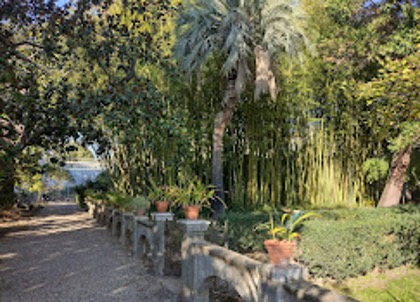
Botanic Museum
Descendant of the ancient Gallery established in 1591 by the Grand Duke of Tuscany Ferdinando I de’ Medici, it still preserves the Quadreria, composed of seventeeth-century portraits of illustrious botanists, the monumental entrance door to the Gallery, and the “Studiolo” used to study and preserve the seeds of the Botanic Garden. It also houses objects related to the teaching of botany since the end of the eighteenth century.
Some are true works of art, such as the botanical models in wax and plaster and the water-coloured teaching tables (19th century).
Other collections hosted are: the in vitro samples of plants, the xylotheque, the teaching models, the botanical instruments and the paleobotany collection.
Finally, at the Botanical Museum, thanks to a multimedia station, it is possible to make a virtual visit among the dried plants (exsiccata) of the herbarium (Herbarium Horti Botanici Pisani), otherwise accessible only to scholars upon reservation.
The University of Pisa is part of the Pisa University System, together with the Scuola Normale Superiore and Sant’Anna School.
The university now has about 48,000 students and consists of 11 faculties and 56 departments offering a notable amount of courses in their related field of studies.

Palazzo Blu
It is the center of temporary exhibitions and different cultural activities managed by Palazzo Blu Foundation
Located on the southern side of Lungarno in the heart of the historic center of the city, a few steps from Ponte di Mezzo and Palazzo Gambacorti, the Town Hall, the ancient noble mansion restored by Pisa Foundation, and run by Palazzo Blu Foundation, is a modern instrument for the enrichment of the city’s cultural offer and is part of the wider tourist development project of the museum circuit overlooking Lungarno, the arterial road of great historical and cultural value that crosses the city from east to west.
How to reach Pisa and move around
Train
Travelling by train is the best way to travel from Pisa to other destinations across Italy.
The ticket office is open between 06:00 and 21:00, or self-serve ticket machines are available all the time. If you’re only travelling a short distance (20km or less) you can buy train tickets from local newsagents. Popular day trips by train from Pisa include Florence (around an hour journey for around 8€) Lucca (15-minute journey for around 5€) and Livorno (15-minute journey for around 3€). Visit the Trenitalia website for information about timetables and fares.
For more info on Italian trains click here.
Car
While travelling around Pisa by car isn’t always an efficient option due to a high volume of daytime traffic, hiring a car is a great way for you to explore Pisa’s outskirts and places further beyond the city.
You’ll get the best price if you book in advance through a provider, where you can pick up a car from either Pisa Airport or the central train station.
Cars for rent are available at the International Galileo Galilei Airport of Pisa, were more than 10 car rental companies operate. Either way, one aspect all tourists getting around by car should keep in mind is that most of the historic centre of Pisa is out of reach if opting for a car, given the centre is under the ZTL (Limited Traffic Zone) restrictions, only public transportation means and resident and authorized vehicles being able to gain access to this area.
Airplane
Pisa has its own airport, reached by many companies including low cost ones.
Pisa airport is located along the coast at only 1 km from the city of Pisa, is accessible from the A11 and A12 motorways, from the Florence-Pisa-Livorno highway, from the normal city roads, and from the railway network.
The airport of Pisa and the train station Pisa Centrale, the city main train station, are connected by the PisaMover, a high-speed shuttle service that runs every day from 6 a.m. to midnight, every 5/8 minutes. The average travel time between the airport and the station is about 5 minutes.
For more info on Pisa airport click here.
Around 80 km from Pisa, and 4 km from the centre of Florence, is located the “Amerigo Vespucci” Airport. Pisa can be reached by train, bus and taxi (around 170 euros). For more Info please visit this link.
Pisa can be reached by train from other airports In Italy.